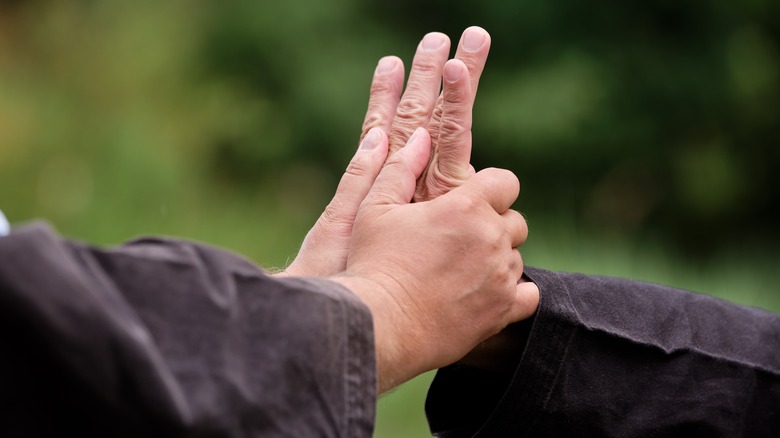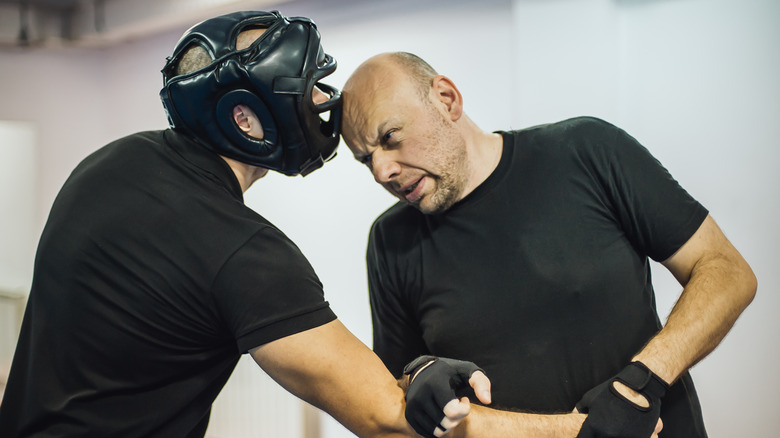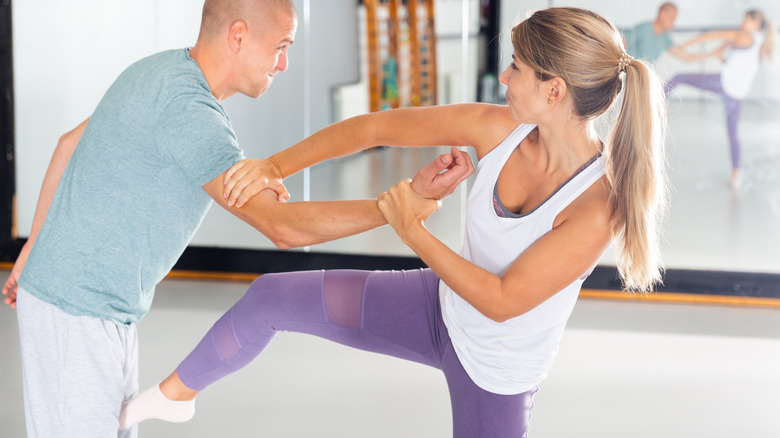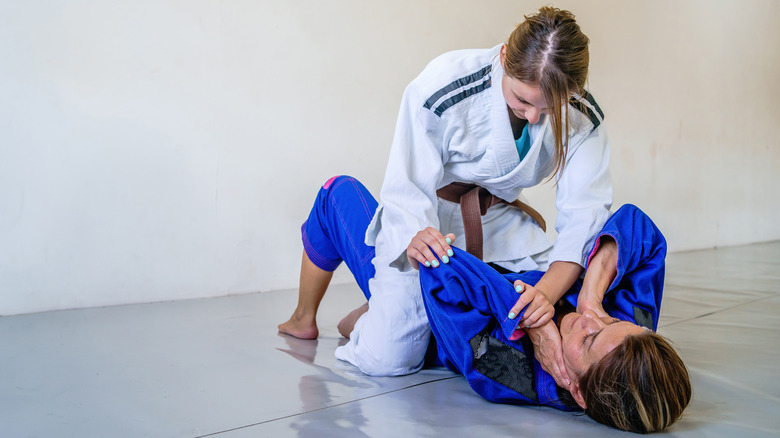10 Self-Defense Moves Every Woman Should Know To Stay Safe
We may receive a commission on purchases made from links.
Sexual harassment and assault are common experiences for many women. According to UN Women, 1 in 3 women on a global scale have been subjected to some form of physical or sexual violence in their lifetime. Violence from intimate partners, strangers, and co-workers is also prevalent, as are incidents of verbal and sexual harassment (via Status of Women Data).
Learning self-defense moves reduces your chances of being a victim of harassment or violence. According to Divas for Defense, women who learn self-defense experience a gigantic boost of empowerment, as well as a range of other health benefits. Practicing self-defense moves not only tones muscles and improves instinctive reflexes, but also teaches self-discipline, helps develop street smarts, and acts as a major self-confidence booster. A 2004 study conducted by Violence Against Women found that self-defense classes also eliminate the fear of sexual assault while helping transform the way women view their bodies, their gender, and their beliefs about men.
In a life or death situation, knowledge is a powerful tool that can save your life. Below are 10 self-defense moves every woman should know to stay safe. Some moves, like the tried-and-true groin kick or straight punch, may seem obvious. However, the more simple a self-defense technique is, the more likely it is to be recalled during a stressful situation (via Prevention).
Trust your instincts and be aware of your surroundings
Despite the simplicity of many self-defense moves, one of the best ways to protect yourself from an attack is to prevent a confrontation from occurring in the first place (via Black Belt). This starts by trusting your instincts. Listening to the voice in your head that senses danger or believes a person or situation is unsafe can help you escape it faster. Women often ignore signs of danger to avoid looking weak, offending someone, or seeming paranoid. However, if you feel something isn't right, it probably isn't.
It is also important to be aware of your surroundings at all times. Engaging in situational awareness means taking note of your environment and what is happening in it, comprehending what those events mean, and planning out how to tackle any situation that may arise because of it (via the American Psychological Association).
According to Street Smart Women, most attackers are looking for vulnerable and unsuspecting targets that will be easy to overpower. A slow, meandering walk, slumped posture, easy-to-remove clothing, and a downcast gaze are all nonverbal indications that you are an easy target. Walking with confidence, keeping your head on a swivel, and making direct eye contact will signal to a potential attacker you are not going down without a fight. It is also important to stick to well-lit areas with people around and wear comfortable clothing so you can move freely.
Focus on the vulnerable parts of the body
In the event you are the victim of a random attack, it is necessary to target your self-defense attacks to the most vulnerable parts of your attacker's body. According to Medium, knowing where to strike is more important than how you strike or the techniques you use to defend yourself. If you can fight back, the best targets to aim for include the eyes, nose, ears, throat, groin, knees, and top of the foot.
When it comes to attacking the eyes, scratching, gouging, spraying, or poking are all excellent ways to disarm an assailant (via American Outdoor Guide). The pain will disorient them long enough for you to escape and find help. Hitting the nose can cause the assailant's nose to bleed and their eyes to water. Repeatedly striking the ears or jaw joint is similarly painful and disorienting, while a direct hit to the throat can cause choking. Groin kicks are effective for incapacitating a male attacker, although multiple hits may be required to get the job done. Many attackers are prepared to be attacked in the groin or the gut, which can make hitting delicate areas like the knee joint or the small bones of the foot particularly useful.
During an attack, picture aiming through these vulnerable areas of the body rather than just hitting them. For example, if you are aiming for the nose, imagine your hand or elbow going through their head rather than stopping at the nose.
Straight punch
A straight punch is a basic but effective self-defense move. It is an instinctual movement that, when executed correctly, can seriously injure an attacker (via Krav Maga). To make the straight punch as effective as possible, aim your punch at the chest, ribs, or throat.
To throw a punch, distribute your weight evenly on both legs with knees slightly bent, Black Belt advises. Make a closed fist, keeping your thumb tucked outside of your curled fingers. If the thumb is tucked within the hand, a solid punch will break it, inhibiting your ability to continue to fight your attacker (via Lifehacker). Use your legs, hips, and torso to put power behind the punch, pivoting on the back foot to throw your arm forward in a straight-line trajectory. Be sure to keep your wrist straight. The first two knuckles on your punching hand should make contact as they are the best supported by the arm bones.
Finger pull
If you find yourself in a physical altercation with another person, breaking their fingers is a surefire way to cause significant damage. Dislocating a finger or breaking it at the joint is excruciating, and the delicate nature of the joints makes doing so relatively easy. This makes the finger pull an excellent self-defense move for women who are smaller or weaker than their attacker (via Coach Up Nation). Finger pulls are ideal in situations where an attacker is reaching for you with an open hand, either from the front or behind.
To execute a finger pull, grab the attacker's little finger and ring finger in one hand and the middle and index finger in your other (via Tip Hero). Pull the fingers apart as you bend the wrist towards the attacker's body, applying forceful pressure in both directions. The resulting extreme pain will likely bring an attacker of any size whimpering to their knees.
Heel palm strike
A heel palm strike is ideal for attacking the nose and throat. According to Made 4 Fighters, this self-defense technique is great for beginners because it reduces the risk of breaking the bones of the hand. It also doesn't require prior knowledge of stance or proper form to be successful. Note that a heel palm strike should only be attempted if you are facing an attacker head-on.
To perform a heel palm strike, flex your dominant wrist so your palm is open and your fingertips are facing the ceiling. Jab upward with the base of your palm, aiming for the nostrils, below the chin, or at the base of the throat near the Adam's apple. The goal is to drive the heel of your palm directly into these sensitive areas of the attacker's face with as much power as possible (via Medium). A successful jab can cause a bloody nose, watering eyes, or fractured bones, although repeated strikes may be necessary to achieve this.
Wrist hold
Many attackers will attempt to subdue their victims by grabbing onto their wrists. An attacker can attempt a wrist hold in several ways, including one hand grabbing one wrist or two hands grabbing two wrists (via Instructables). No matter how an attacker grabs you, knowing how to successfully escape a wrist hold will ensure you can break free every time.
According to CPI Security, it is easy to rotate your wrists to free your hands from the attacker's grip. Instinctually, you will want to pull your arm backward towards your body like a tug-of-rope. Unfortunately, the resulting struggle will exhaust you long before it tires out an attacker.
To properly escape you will need to widen your stance and squat down, lean your torso forward, and bend your elbows (via ASU Police Department). Then, twist your arms towards the attacker's thumb and turn your open palms down towards the ground. Using force, yank your hand or arms downward to break free from the wrist hold.
Hammer strike
A hammer strike, or hammer fist strike, is a popular self-defense move for women because it is quick, easy to perform, and allows for maximum impact on an attacker, according to Code Red Defense. Hammer strikes are an ideal move when someone is attacking you from the front.
A hammer strike can be done with objects like car keys, or with a bare, closed fist. If you opt for car keys, hold your key ring in a tight fist as if you are holding a hammer handle. The sharp ends of the keys should stick out of the side of your hand. Alternatively, clip your keys to a lanyard and swing it downward like a mace.
To perform a hammer strike, raise your dominant arm above your head, bending at the elbow as if you are planning to throw a ball (via Real Simple). Then, thrust downward at your target with as much power as possible. Recoil and repeat until your attacker is incapacitated and you have the opportunity to run away.
Elbow strike
Depending on how close an attacker is, using your hands to punch or strike may not be an option. If you cannot use your hands to defend yourself, your elbows make excellent alternative weapons. They are located closer to your core and made of sharp bone that is much stronger than the bones of your hand, according to Made 4 Fighters. This combination makes the elbow strike one of the most powerful self-defense moves, perfect for close-quarter combat.
There are numerous ways to perform an elbow strike. The basic, most natural version is the horizontal elbow strike. This involves bending the elbow and holding it parallel to the floor at shoulder level. Aiming for the ear, temple, or chin of the attacker, the elbow travels horizontally over the ground until it makes contact (via Sweet Science of Fighting). Pivot on the back foot to give the strike maximum power. When throwing an elbow strike, it is important to focus on landing your elbow in as small a region as possible for best results.
Headbutt to face
If your attacker has control of your arms in a standing position, the headbutt is a great way to fight back, according to Defender Ring. Headbutting takes the hardest part of your body and brings it into contact with the softer parts of the attacker's face. It can bring a man to his knees and is equally effective at causing painful lacerations. However, it may take more than one strike to properly subdue an assailant.
First, tuck your chin to protect your neck and force the crown of your head to do the heavy hitting (via Warrior Life). If possible, grab hold of your attacker's collar or the back of their neck and use this motion to pull them forward into the headbutt. You can also throw a headbutt in reverse if an assailant has you trapped from behind. Aim for the eyes, the nose, and other soft parts of the face (via Skillset Mag).
Groin kick
Women are taught early on that the best way to defend themselves from a male assailant is to give them a swift kick to the groin. Although the move itself is effective, it is not always as simple as you might think. Some men have stronger pain tolerances, while others may have come to the fight prepared by wearing a cup, as Self Defense Tutorials reports. If you perform a weak groin kick and your attacker doesn't immediately crumple as you expect, you may end up in more danger than you started.
If a groin kick is the only option you have, it is important to execute the move correctly. If the attacker is approaching you head-on, lift your knee above your waist and kick out, using your hips to give the move some extra power (via Real Simple). Kicking your foot in a hook-like motion at the groin is ideal to implement the most pain. Picture scooping your foot like an ice cream scoop as you bring it back toward your body (via Divas For Defense).
Remember that the groin kick should be used as a last-ditch opportunity to escape your attacker. If more than one kick is necessary to bring them down, focus on adding other moves that target various parts of their body.
Mount position
Not all self-defense moves are about striking out against an opponent. Knowing how to escape from certain situations an attacker may force on you is just as valuable when it comes to protecting yourself.
If you find yourself lying on the ground with an attacker sitting on your chest, you are in a dangerous position called the mount (via Self Defense Tutorials). The mount position allows the person sitting on top of you to have a full range of motion, pin you down with their full weight, and puts you at the mercy of their attacks. The position makes it nearly impossible to put up a real fight with punching or kicking and requires an alternative escape plan.
The easiest way to escape a mount position is to get your attacker unbalanced, according to Functional Self Defense. Placing both feet firmly on the ground, push your pelvis up as high as you can into a bridge position. This will force your attacker to shift his weight towards your head and catch himself with his hands. Then, grab onto the attacker's arm or leg and use it to roll out from underneath them. Once you are no longer trapped, you can implement one of the self-defense moves you know to disorient them.
Bear hug defense
Many attackers prefer the bear hug technique to subdue their victims. A bear hug can come from either the front or behind and pins your arms to your sides. It combines the element of surprise while removing your ability to use your hands or arms to fight back (via Survival Sullivan). Bear hugs are also often used as the primary tool for kidnapping.
There are multiple ways to defend against a bear hug attack depending on the direction the attacker is coming from. However, according to Krav Maga Mindset, most bear hugs come from behind . To combat this attack, drop into a squat position and get as heavy as possible. If your arms are trapped, use your legs and feet to stomp, kick, and knee any part of the attacker that you can reach. Repeatedly hit your attacker until they release you. As you are fighting back, yell as loudly as you can to bring attention to yourself.
Precautions to take if you aren't able to protect yourself physically
Depending on your body's limitations, you may not be able to perform certain self-defense moves. There are several precautions you can take if you aren't confident you can protect yourself physically. For example, there are a variety of personal protection items you can wear or carry which helps provide peace of mind.
Stun guns, brass knuckles, and pepper spray keychains are also useful for de-escalating a violent situation. According to Right as Rain by UW Medicine, it is important to practice carrying and using such weapons. Keep them in an accessible place and training with them ensures you will use them effectively if and when the time comes.
Don't underestimate the power of your voice either. If you find yourself in an uncomfortable situation with an attacker, yell "Fire!" as loudly as you can (via Crime Safety Security). This will not only confuse your attacker and buy you precious time to use your defense weapons, but it will draw attention to you faster than simply yelling "Stop!"
Seek out a safe space to practice
Executing physical self-defense moves when you have never done so before can feel intimidating. Although referring to this guide is useful for understanding the fundamentals of basic self-defense techniques, practice makes perfect when it comes to mastering them. It is wise to seek out a qualified instructor and learn how to do the moves correctly and safely. According to Tiger Rock, practical self-defense training is the best way to prepare your mind and body for worst-case scenarios. It is also a great form of exercise that has positive benefits for your physical health.
Self-defense classes are given for free on many college campuses and at local police departments (via Divas for Defense). Local boxing and martial arts gyms are excellent spaces to learn how to safely spar and grapple with an opponent. Many online courses and apps are also available if you need a practical demonstration right away.














